Convertkit Review: Is the pricing worth it in 2024?
Introduction:
This article is a comprehensive ConvertKit review, where we’ll figure out if the cost of this email tool is worth it. Nowadays, lots of businesses use email marketing to connect with people. So, we will see if ConvertKit is a good deal by looking at what it can do and how much it costs.
We’ll check out ConvertKit’s easy-to-use setup and how it helps with sending emails automatically. Then, we’ll consider whether the things it does are worth the money it asks for. With so many choices out there, it’s essential to understand if ConvertKit’s price is wise to spend based on what good stuff it brings and if it fits different types of businesses. Let’s start looking into all of this and decide after reading this ConvertKit review if it is the right pick for your email needs.
Key Takeaways:
Overview:
ConvertKit is a comprehensive email marketing platform that caters to the needs of bloggers, content creators, and small businesses. Launched in 2013, it has steadily gained a reputation for its focus on simplicity and automation. Unlike traditional email marketing tools, ConvertKit emphasizes the importance of personalization and segmentation, enabling users to target their audience effectively.


Features and Functionalities: Convertkit Review
ConvertKit offers a variety of features and functionalities designed to simplify and enhance your email marketing campaigns. Some of the key features include:
Ease of Use:
ConvertKit is designed to make email marketing easy and intuitive for creators. It has a clear and user-friendly layout that lets you create sign-up forms, landing pages, newsletters, and automation with ease.
User interface and navigation
ConvertKit boasts a user-friendly interface that makes it easy for users to navigate and utilize its features effectively. The interface is clean, intuitive, and organized, allowing you to find the necessary tools and settings without confusion.
The navigation in ConvertKit is straightforward, with a well-structured menu that gives you access to different sections, such as subscribers, forms, sequences, and broadcasts. The platform’s layout ensures that key functionalities are easily accessible, allowing you to manage your email marketing campaigns efficiently.
Ease of creating email campaigns
Creating email campaigns in ConvertKit is designed to be simple and efficient. You can easily create new email sequences or broadcasts from pre-designed templates or start from scratch. The drag-and-drop editor lets you customize the content, add images, format text, and include call-to-action buttons.


Learning curve
While ConvertKit takes delight in its user-friendliness, newcomers to email marketing or automation tools may experience a slight learning curve. The platform offers comprehensive documentation, video tutorials, and customer support to assist users in navigating through any challenges they may encounter.
ConvertKit is designed with user-friendliness in mind, and beginners can quickly adapt to its interface and functionalities with the available resources.
Email Automation and Segmentation
Automation capabilities:
ConvertKit excels in its email automation capabilities, empowering users to streamline their email campaigns and deliver personalized content at scale. With ConvertKit, you can create powerful automation sequences triggered by subscriber behavior or specific conditions.
Automation in ConvertKit revolves around sequences and emails sent to subscribers based on predefined rules. You can easily create automation sequences using a visual workflow builder, where you connect different actions, conditions, and triggers. For example, you can create an automation sequence to welcome new subscribers, nurture leads, or re-engage inactive subscribers.
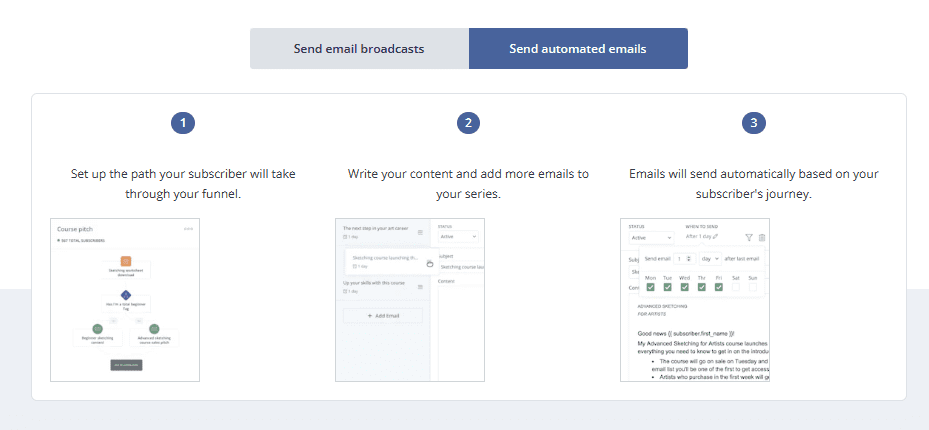

Segmentation
In our ConvertKit review, we find that segmentation plays a vital role in making email marketing work well. This tool gives you strong ways to do segmentation, so you can aim at your audience better. ConvertKit lets you make groups and labels using different things like what your subscribers like, how they act, or facts about them.
Segments in ConvertKit are dynamic, meaning they update automatically based on the conditions you set. For example, you can create a segment for subscribers who clicked a specific link in your email or those who have made a purchase. This enables you to send highly targeted emails to specific segments, ensuring your messages are relevant and engaging.
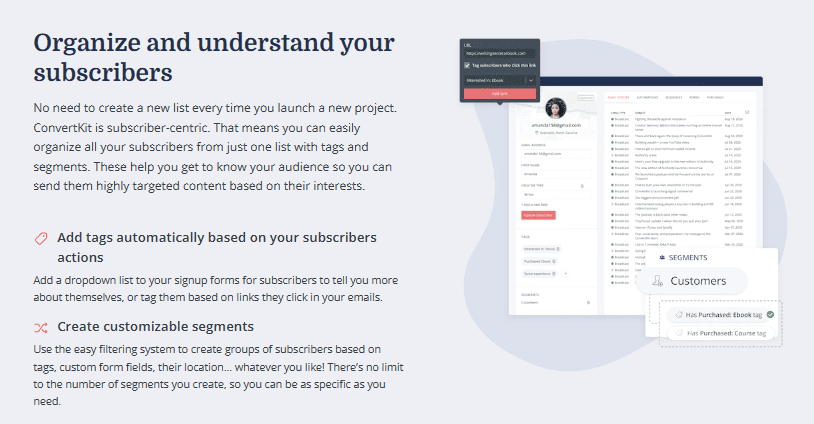

Visual Automation:
We discovered in doing this Convertkit review that this platform offers a unique feature called “Visual Automations,” allowing you to create sophisticated automation workflows easily. The visual automation builder visually represents your automation sequences, making mapping out your email campaigns intuitive and straightforward. Another unique tool in ConvertKit is the “Resend to Unopens” feature. With this feature, you can automatically resend your email broadcasts to subscribers who didn’t open the initial email. This allows you to increase your open rates and reach a wider audience without manual effort.
ConvertKit also provides a feature called “Conversions,” which allows you to track and measure the success of your email opt-ins and sign-ups. These unique features and tools in ConvertKit enhance automation and segmentation, allowing you to create effective and personalized email marketing campaigns.
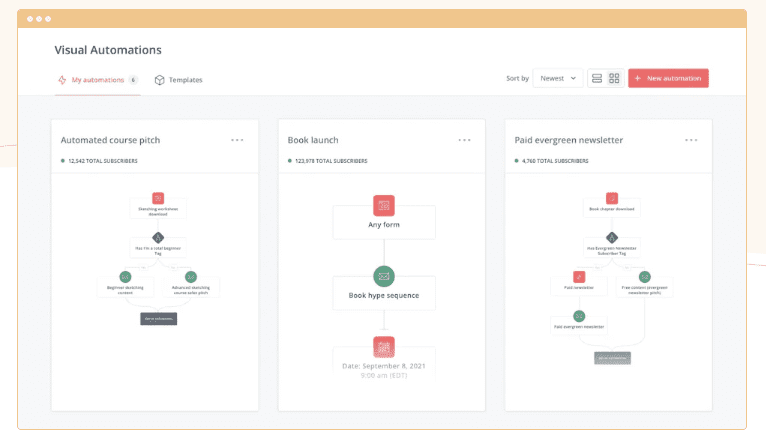

Email Template and Design Options
Email template library and customization options
ConvertKit provides a range of email templates that you can choose from to create visually appealing and professional-looking emails. While the template library may not be as extensive as other email marketing platforms, ConvertKit offers clean, minimalist, and easy-to-customize templates.
Flexibility and creativity allowed in designing email templates
ConvertKit offers a good level of flexibility and creativity when it comes to designing email templates. The platform provides a drag-and-drop email editor that allows you to customize the layout, add or rearrange content blocks, and style your emails without requiring coding knowledge.
You can personalize your emails by adding dynamic content, such as the subscriber’s first name or other custom fields, using ConvertKit’s merge tag feature.


Email Deliverability:
ConvertKit’s email deliverability feature is designed to help users ensure that their emails land in the inbox of their subscribers. ConvertKit uses a variety of techniques to improve email deliverability, including:
- IP reputation: ConvertKit has a good reputation with email providers, which means that emails sent from ConvertKit are more likely to be delivered to the inbox.
- Authentication: ConvertKit uses authentication protocols to verify that emails are coming from a legitimate source. This helps to prevent emails from being blocked as spam.
- List hygiene: ConvertKit provides tools to help users clean their email lists and remove inactive subscribers. This helps to improve email deliverability by ensuring that emails are only being sent to people who want to receive them.
- Email content: ConvertKit analyzes email content for spammy keywords and phrases. This helps users to avoid sending emails that are likely to be blocked as spam.
ConvertKit as a Landing Page Builder:
ConvertKit excels as an email marketing software and offers a landing page builder that enables users to create and publish attractive and effective landing pages. This feature allows you to capture leads, promote products or services, and drive conversions without needing third-party landing page tools.
- Easy-to-Use Interface: ConvertKit’s landing page builder is designed with simplicity in mind. The intuitive interface and drag-and-drop functionality make it easy for users, even those without design or coding experience, to create professional-looking landing pages. You can select from a variety of pre-designed templates.
- Customizable Templates: ConvertKit offers a collection of customizable landing page templates that cater to different goals and industries. These templates are designed to be visually appealing, mobile-responsive, and optimized for conversion.
- Integration and Publishing: ConvertKit’s landing page builder integrates smoothly with your existing ConvertKit account, allowing you to manage leads and automate email sequences effortlessly. Once you’ve built your landing page, ConvertKit provides a custom domain or subdomain option for hosting, or you can use your domain.
ConvertKit’s landing page builder complements its email marketing capabilities, allowing users to seamlessly capture leads, drive conversions, and integrate their landing pages with their email marketing campaigns.
Landing Pages And Forms:
ConvertKit offers a variety of landing page templates and forms to help users collect email addresses and grow their audience. The landing page templates are customizable, so users can create landing pages that match their brand and style.
To create a landing page in ConvertKit, users can simply choose a template and then add their own content, such as a headline, subheadline, body text, and call to action. Users can also add images and videos to their landing pages.
ConvertKit also offers a variety of form templates, such as email subscription forms, contact forms, and purchase forms. Users can customize the form templates to match their landing pages and to collect the information they need from their subscribers.
Once a user has created a landing page or form, they can embed it on their website or share it on social media.
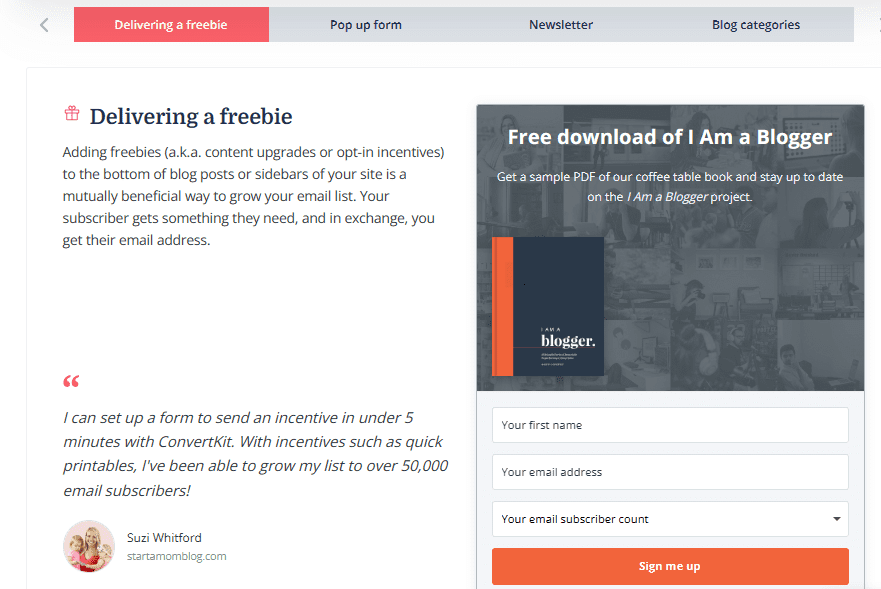

E-Commerce:
ConvertKit Commerce is a feature that allows users to sell digital products directly from their email lists. ConvertKit Commerce is easy to use and requires no coding knowledge.
To sell a digital product with ConvertKit Commerce, users simply need to create a product page, set a price, and choose a payment processor. ConvertKit Commerce integrates with Stripe, so users can easily accept payments from their subscribers.
Once a user has created a product page, they can add a link to the product page in their emails or on their website. When a subscriber clicks on the link and purchases the product, they will be immediately redirected to the download page.
Integrations:
ConvertKit integrates with a variety of other platforms, including WordPress, Shopify, Stripe, and Zapier. This makes it easy to connect ConvertKit to other parts of your marketing workflow.
You can integrate ConvertKit with WordPress to import your WordPress subscribers into ConvertKit. You can also integrate ConvertKit with Shopify to automatically add new Shopify customers to your ConvertKit list. And you can integrate ConvertKit with Stripe to accept payments directly from your subscribers.
Zapier is a powerful integration tool that allows you to connect ConvertKit to over 4,000 other apps. This means that you can automate almost any task in your marketing workflow.
You can use Zapier to create a zap that automatically sends a welcome email to new subscribers. You can also use Zapier to create a zap that adds new subscribers to a specific tag based on their interests.
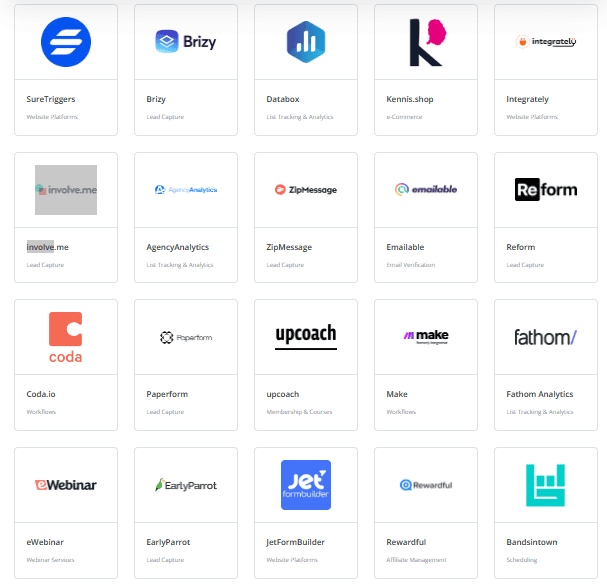

Analytics and Reporting
In this section, we continue our Convertkit review on analytics and reporting and how it helps marketer optimize their marketing campaigns:
Analytics and reporting features
In our Convertkit review, we learned that the platform offers a range of analytics and reporting features to help you track the performance of your email marketing campaigns. These tools provide valuable insights into subscriber engagement, campaign effectiveness, and overall email marketing success.
The analytics dashboard in ConvertKit provides an overview of key metrics and data, allowing you to monitor the performance of your campaigns at a glance. You can track open rates, click-through rates, unsubscribe rates, and overall subscriber growth.
Key metrics and data available to track campaign performance
ConvertKit provides a comprehensive set of metrics and data to track the performance of your email campaigns. Some of the key metrics and data available include:
- Open Rates: This metric measures the percentage of subscribers who open your emails. It gives you insights into the effectiveness of your subject lines and overall email deliverability.
- Click-Through Rates (CTRs): CTRs indicate the percentage of subscribers who click on links within your emails. It helps you assess the engagement levels and effectiveness of your call-to-action buttons or links.
- Unsubscribe Rates: Unsubscribe rates show the percentage of subscribers who opt out of receiving future emails. Monitoring this metric helps you understand the impact of your content and email frequency on subscriber retention.
- Subscriber Growth: ConvertKit provides data on subscriber growth over time, allowing you to track the growth rate of your email list. This data helps you evaluate the success of your lead generation efforts and overall audience growth.


Customer Support and Resources
Customer support is crucial, thus, we need to include this in our ConvertKit review:
Customer support channels
ConvertKit aims to provide reliable and helpful customer support to its users. The platform offers multiple channels through which users can seek assistance and resolve issues.
- Email Support: ConvertKit offers email support, allowing users to submit their queries or concerns via email. The support team strives to respond promptly and provide assistance promptly.
- Help Center: ConvertKit maintains a comprehensive help center that serves as a knowledge base for users. It contains a wide range of articles, guides, and frequently asked questions (FAQs) that cover various topics related to using ConvertKit effectively.
Tutorials and Educational Resources
In our ConvertKit review, we discovered that this solid software provides extensive documentation and tutorials to help users navigate and make the most of the platform’s features. The documentation covers various aspects of ConvertKit, including setting up an account, creating email campaigns, configuring automation sequences, and integrating with other tools. These resources serve as a valuable reference for users who prefer self-guided learning.
Customer Support Responsiveness
ConvertKit is known for its responsive and helpful support team. Users have reported positive experiences with ConvertKit’s customer support, citing prompt responses and efficient resolution of their queries.
ConvertKit strives to offer its users reliable and effective customer support. The combination of email support, comprehensive documentation, tutorials, educational resources, and an engaged user community ensures users can access the assistance they need to make the most of the platform.
Pricing Plans:
Different pricing tiers
ConvertKit offers different pricing tiers to cater to the needs of various users. The pricing structure is based on the number of subscribers in your email list, allowing you to choose a plan that aligns with the size of your audience.
- Free Plan: ConvertKit offers a free plan that allows users to get started with basic email marketing features. The free plan is limited to 1,000 subscribers. However, it provides an excellent opportunity for users to explore the platform and evaluate its suitability for their needs before committing to a paid plan. You can have unlimited landing pages and broadcasts.
- Creator Plan: The Creator plan is the entry-level paid plan for ConvertKit. It offers more advanced features and allows users to have up to a certain number of subscribers. Pricing starts at $ 15/month for 300 subscribers. This plan includes unlimited landing pages, customizable opt-in forms, email broadcasts, automation sequences, and basic reporting.
- Creator Pro Plan: The Creator Pro plan is the premium plan offered by ConvertKit. It includes all the features of the Creator plan but with additional benefits and enhanced functionality. This plan provides advanced reporting, integrations with third-party tools, subscriber scoring, advanced automation features, and priority customer support. Pricing starts at $29/month for 300 subscribers.


Pros and Cons:
Pros:
- User-Friendly Interface: ConvertKit offers a user-friendly interface that is intuitive and easy to navigate. The platform’s clean design and straightforward workflows make it accessible to users of all levels of technical expertise.
- Powerful Automation Capabilities: ConvertKit’s robust automation features allow users to create complex automation sequences without requiring extensive technical knowledge.
- Creator-Focused Features: ConvertKit is specifically designed with creators in mind. It offers features such as customizable opt-in forms, landing page builders, and email templates that cater to bloggers, podcasters, and other content creators’ unique needs.
- Segmentation Options: ConvertKit provides robust segmentation options, allowing users to target specific audience subsets with personalized content.
- Dedicated Support and Resources: ConvertKit offers responsive customer support through email channels, a comprehensive help center, and educational resources.
Cons:
- Limited Visual Design Customization: While ConvertKit offers some flexibility in email template customization, it may provide a different level of design options than some other email marketing tools.
- Pricing Structure: ConvertKit’s pricing plans are based on the number of subscribers, which can disadvantage users with rapidly growing email lists. As the subscriber count increases, the cost of using ConvertKit can become relatively higher compared to other email marketing platforms.
- Advanced Reporting Features: While ConvertKit provides essential reporting metrics, the platform’s reporting capabilities may not be as comprehensive as those offered by other email marketing tools.
- Limited E-commerce Integration: ConvertKit does offer some integration options with e-commerce platforms, but the level of integration may not be as extensive as other dedicated e-commerce email marketing tools.
- Learning Curve for Beginners: Although ConvertKit is designed to be user-friendly, beginners may still face a learning curve when initially utilizing the platform’s features.
ConvertKit User Success Stories:
Summary And Recommendations:
This is a summary of our Convertkit review. ConvertKit is an email marketing software catering to creators and small businesses. With its user-friendly interface, powerful automation capabilities, and creator-focused features, ConvertKit offers a compelling solution for managing and optimizing email marketing campaigns.
In terms of pricing, ConvertKit offers a free plan for users to get started, as well as paid plans that scale based on the number of subscribers. While the pricing may be higher compared to some other platforms, the value lies in ConvertKit’s focus on simplicity, automation, and features tailored for creators and small businesses.
ConvertKit offers a user-friendly and powerful email marketing solution for creators and small businesses. Its automation capabilities, segmentation options, and creator-focused features make it a valuable investment for those looking to grow their business through email marketing.


ConvertKit
Unlock the full potential of your audience with ConvertKit, the creator marketing platform designed to help you optimize your most important asset. ConvertKit empowers you to connect with your audience like never before. Try ConvertKit today and take your creator journey to new heights!
Pro Tip 1:
Pro Tip 2:
Affordable Convertkit Alternative with More Features:
If your budget is tight, take a look at this more affordable alternative platform below:
While ConvertKit offers robust email marketing features, alternative platforms that provide similar capabilities at a more affordable price point are available. One such platform is Systeme.io. If you’re looking for a cost-effective solution without compromising functionality, Systeme.io may be the ideal choice for your email marketing needs.
Systeme.io is an all-in-one marketing platform offering a comprehensive tool suite to help you build, automate, and grow your online business. It provides a range of features and capabilities that can rival ConvertKit while offering a more budget-friendly pricing structure.
Comparison:
| Features | Systeme.io | Convertkit |
| Price | Free | Free |
| Contacts | 2,000 | 1,000 |
| Sales Funnels |                    | Landing page |
| Deadline Funnels |                    |          |
| Emails sent | Unlimited | Unlimited |
| Email campaigns |                    |                    |
| Blogs |                    |          |
| Blog posts |                    |          |
| Courses | 1 |          |
| Students | Unlimited |          |
| Automation rules |                    | Starts @$25/mo |
| Workflows |                    |          |
| Paypal integration |                    |          |
| Transaction fees | None | 3.5%+3c |
| Tags |                    |                    |
| A/B Tests |                    |                    |
| 1-click upsells |                    |                    |
| Order bumps |                    |                    |
| Run own affiliate program |                    |          |
From the comparison table, it is very clear that using Systeme.io is more advantageous pricewise and featurewise. Try their Free Forever Plan to experience its versatility and power. If you are using another platform, you can migrate for free to Systeme.io’s platform by availing their start-up plan. Take advantage of the 30% special discount now, which is available on a limited-time basis only.
Save $ 1,344 annually using Systeme.io.
The most significant disadvantage of Convertkit is the increase in cost as the number of subscribers increases. If you manage 15,000 subscribers, Convertkit’s Creator Pro Plan would amount to $209/month.
On the other hand, the Unlimited plan of Systeme.io, which manages unlimited subscribers, would amount to only $97/month.
The good news is that the Unlimited plan is now available at a special 30% discount plus free migration to Systeme.io’s platform. Take advantage of this special price while still available.
Key Features and Capabilities:
- Email Marketing Automation: Systeme.io lets you effortlessly automate your email marketing campaigns. You can create automated sequences, set up triggers based on subscriber actions, and send personalized emails to nurture leads and engage with your audience.
- Landing Page Builder: With Systeme.io’s intuitive landing page builder, you can create stunning, high-converting landing pages without coding knowledge. Customize the design, add opt-in forms, and optimize your pages for maximum conversions.
- Sales Funnel Builder: Systeme.io enables you to build complete sales funnels to guide your audience through the buying journey. Create upsells, downsells, order bumps, and thank-you pages to maximize your revenue and provide a seamless customer experience.
- Membership Sites: Systeme.io allows you to create membership sites and deliver exclusive content to your subscribers. Set up different membership levels, protect your content, and provide a valuable subscription-based offering.
- CRM and Segmentation: Systeme.io includes a built-in CRM system to manage your contacts effectively. Segment your subscribers based on various criteria, such as tags, behavior, or purchase history, to deliver targeted emails and tailor your marketing messages.
- Webinar Integration: Systeme.io integrates seamlessly with popular webinar platforms, making it easy to host webinars, generate leads, and engage with your audience effectively.
- E-commerce Functionality: Systeme.io provides robust e-commerce features to support online sales. Manage orders, integrate payment gateways, and deliver digital products or online courses to monetize your knowledge.
- Affiliate Management: Systeme.io allows you to run your affiliate program, empowering you to incentivize affiliates to promote your products and services and drive more sales.
- Analytics and Reporting: Systeme.io provides comprehensive analytics and reporting to track the performance of your email marketing campaigns, sales funnels, and overall business growth.
- A/B Split Testing: Systeme.io enables you to run A/B split tests to optimize your email campaigns and sales funnels. Test different subject lines, content variations, and call-to-action buttons to identify the most effective elements.
- Social Proof and Reviews: Display social proof, such as testimonials and reviews, on your landing pages and sales funnels to build trust and credibility with your audience.
- Integrations: Systeme.io integrates with popular third-party tools and platforms, allowing you to connect and streamline your workflow easily. Integrate with payment gateways, marketing automation tools, and more.
- Integrations: Systeme.io integrates with popular third-party tools and platforms, allowing you to connect and streamline your workflow easily. Integrate with payment gateways, marketing automation tools, and more.
Final Thoughts:
What sets Systeme.io apart is its affordable pricing structure, particularly for users with more extensive subscriber lists. It offers competitive pricing plans that can save you significantly compared to other email marketing platforms. Systeme.io’s user-friendly interface and extensive documentation make it easy for beginners to get started quickly.
Systeme.io presents an affordable alternative with comparable capabilities. With its email automation, landing page builder, sales funnels, CRM, and other robust features, Systeme.io is a comprehensive all-in-one marketing platform that can help you grow your online business without paying through the nose.
If you’re looking for a cost-effective solution that doesn’t compromise functionality, we highly recommend giving Systeme.io a try. Its extensive features, affordability, and user-friendly interface make it a compelling choice for creators and small businesses alike.


Systeme.io
Systeme.io is the best way to start and scale your online business. It gives you everything you need to create sales funnels, email campaigns, online courses, and more. And it’s incredibly affordable – you can get started for free and pay as you grow. Don’t miss this opportunity – sign up for the Free Version Forever Plan now.
Related Article:










I was recommended this website through my cousin. I’m now not positive whether this submit is written through him as nobody else recognize such distinct about my problem. You’re wonderful! Thanks!